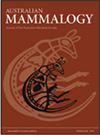松鼠滑翔机种群调查中聚光和诱捕的比较
IF 1.2
4区 生物学
Q3 ZOOLOGY
引用次数: 1
摘要
树栖哺乳动物的种群监测应通过估计不同方法的检测概率来进行。我们在36个样带上进行了诱捕和聚光,以探测松鼠滑翔机(北富尔逊龙)。在五次会议上进行了重复调查。我们使用多方法占用来比较这些方法。在一个晚上的聚光灯照射下,检测到的概率没有差异(0.23 ± 0.04,平均值 ± s.e.),或一晚的诱捕(0.22 ± 0.03)。诱捕持续了三个晚上,导致被发现的概率上升到0.41 ± 0.04.每次会议只进行一次聚光灯照明。这些方法在三个晚上进行时需要付出同等的努力。需要进一步的研究来比较这种方法和其他方法,如相机捕捉和聚光灯与热像仪。本文章由计算机程序翻译,如有差异,请以英文原文为准。
Comparison of spotlighting and trapping in population surveys of the squirrel glider
Population monitoring of arboreal mammals should be informed by estimates of detection probabilities from different methods. We employed trapping and spotlighting across 36 transects to detect the squirrel glider (Petaurus norfolcensis). Repeat surveys were conducted over five sessions. We used multi-method occupancy to compare these methods. The probability of detection did not differ between one night of spotlighting (0.23 ± 0.04, mean ± s.e.), or one night of trapping (0.22 ± 0.03). Trapping continued for three nights, which led to the probability of detection rising to 0.41 ± 0.04. Spotlighting was only conducted once per session. These methods would require equivalent effort when conducted over three nights. Further investigation is required to compare this and other methods such as camera trapping and spotlighting with thermal cameras.
求助全文
通过发布文献求助,成功后即可免费获取论文全文。
去求助
来源期刊

Australian Mammalogy
ZOOLOGY-
CiteScore
2.50
自引率
8.30%
发文量
26
期刊介绍:
Australian Mammalogy is a major journal for the publication of research in all branches of mammalogy. The journal’s emphasis is on studies relating to Australasian mammals, both native and introduced, and includes marine mammals in the Antarctic region. Subject areas include, but are not limited to: anatomy, behaviour, developmental biology, ecology, evolution, genetics, molecular biology, parasites and diseases of mammals, physiology, reproductive biology, systematics and taxonomy.
Australian Mammalogy is for professional mammalogists, research scientists, resource managers, consulting ecologists, students and amateurs interested in any aspects of the biology and management of mammals.
Australian Mammalogy began publication in 1972 and is published on behalf of the Australian Mammal Society.
 求助内容:
求助内容: 应助结果提醒方式:
应助结果提醒方式:


